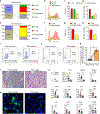Mitochondrial aspartate regulates TNF biogenesis and autoimmune tissue inflammation
- PMID: 34811544
- PMCID: PMC8756813
- DOI: 10.1038/s41590-021-01065-2
Mitochondrial aspartate regulates TNF biogenesis and autoimmune tissue inflammation
Abstract
Misdirected immunity gives rise to the autoimmune tissue inflammation of rheumatoid arthritis, in which excess production of the cytokine tumor necrosis factor (TNF) is a central pathogenic event. Mechanisms underlying the breakdown of self-tolerance are unclear, but T cells in the arthritic joint have a distinctive metabolic signature of ATPlo acetyl-CoAhi proinflammatory effector cells. Here we show that a deficiency in the production of mitochondrial aspartate is an important abnormality in these autoimmune T cells. Shortage of mitochondrial aspartate disrupted the regeneration of the metabolic cofactor nicotinamide adenine dinucleotide, causing ADP deribosylation of the endoplasmic reticulum (ER) sensor GRP78/BiP. As a result, ribosome-rich ER membranes expanded, promoting co-translational translocation and enhanced biogenesis of transmembrane TNF. ERrich T cells were the predominant TNF producers in the arthritic joint. Transfer of intact mitochondria into T cells, as well as supplementation of exogenous aspartate, rescued the mitochondria-instructed expansion of ER membranes and suppressed TNF release and rheumatoid tissue inflammation.
© 2021. The Author(s), under exclusive licence to Springer Nature America, Inc.
Conflict of interest statement
Declaration of Interests
The authors have declared that no conflict of interest exists.
Figures


















Comment in
-
Shortage of aspartate in mitochondria fuels arthritis.Nat Immunol. 2021 Dec;22(12):1474-1476. doi: 10.1038/s41590-021-01069-y. Nat Immunol. 2021. PMID: 34811543 Free PMC article.
-
Mitochondrial signals regulate ER size and TNF production in rheumatoid arthritis.Nat Immunol. 2021 Dec;22(12):1477-1478. doi: 10.1038/s41590-021-01070-5. Nat Immunol. 2021. PMID: 34837082 No abstract available.
-
Mitochondria Transfer to CD4+ T Cells May Alleviate Rheumatoid Arthritis by Suppressing Pro-Inflammatory Cytokine Production.Immunometabolism. 2022;4(2):e220009. doi: 10.20900/immunometab20220009. Epub 2022 Mar 18. Immunometabolism. 2022. PMID: 35444834 Free PMC article.
Similar articles
-
Metabolic checkpoints in rheumatoid arthritis.Semin Arthritis Rheum. 2025 Feb;70S:152586. doi: 10.1016/j.semarthrit.2024.152586. Epub 2024 Nov 8. Semin Arthritis Rheum. 2025. PMID: 39550308 Review.
-
Metabolic Control of Autoimmunity and Tissue Inflammation in Rheumatoid Arthritis.Front Immunol. 2021 Apr 2;12:652771. doi: 10.3389/fimmu.2021.652771. eCollection 2021. Front Immunol. 2021. PMID: 33868292 Free PMC article. Review.
-
TNF-α signals through ITK-Akt-mTOR to drive CD4+ T cell metabolic reprogramming, which is dysregulated in rheumatoid arthritis.Sci Signal. 2024 Apr 23;17(833):eadg5678. doi: 10.1126/scisignal.adg5678. Epub 2024 Apr 23. Sci Signal. 2024. PMID: 38652761
-
Tumor necrosis factor receptor type I expression of CD4+ T cells in rheumatoid arthritis enables them to follow tumor necrosis factor gradients into the rheumatoid synovium.Arthritis Rheum. 2013 Jun;65(6):1468-76. doi: 10.1002/art.37927. Arthritis Rheum. 2013. PMID: 23494522
-
Mast cell activation and its relation to proinflammatory cytokine production in the rheumatoid lesion.Arthritis Res. 2000;2(1):65-74. doi: 10.1186/ar70. Arthritis Res. 2000. PMID: 11219391 Free PMC article.
Cited by
-
Survival advantage of native and engineered T cells is acquired by mitochondrial transfer from mesenchymal stem cells.J Transl Med. 2024 Sep 27;22(1):868. doi: 10.1186/s12967-024-05627-4. J Transl Med. 2024. PMID: 39334383 Free PMC article.
-
Aspartate Is A Determinant of TNF-α Biogenesis in Sub-Saharan Africa: Insight Into the Pathogenesis of Noncommunicable Diseases.FASEB J. 2025 Jun 15;39(11):e70703. doi: 10.1096/fj.202500738R. FASEB J. 2025. PMID: 40489164 Free PMC article.
-
Nanomedicine-based immunotherapy for tissue regeneration.Burns Trauma. 2025 Feb 10;13:tkaf015. doi: 10.1093/burnst/tkaf015. eCollection 2025. Burns Trauma. 2025. PMID: 40568375 Free PMC article. Review.
-
Lucidenic acid A inhibits the binding of hACE2 receptor with spike protein to prevent SARS-CoV-2 invasion.Food Chem Toxicol. 2022 Nov;169:113438. doi: 10.1016/j.fct.2022.113438. Epub 2022 Sep 28. Food Chem Toxicol. 2022. PMID: 36179993 Free PMC article.
-
Analyzation of the Peripheral Blood Mononuclear Cells Atlas and Cell Communication of Rheumatoid Arthritis Patients Based on Single-Cell RNA-Seq.J Immunol Res. 2023 Aug 12;2023:6300633. doi: 10.1155/2023/6300633. eCollection 2023. J Immunol Res. 2023. PMID: 37600067 Free PMC article.
References
References for Methods
Publication types
MeSH terms
Substances
Grants and funding
LinkOut - more resources
Full Text Sources
Other Literature Sources
Medical
Research Materials
Miscellaneous

